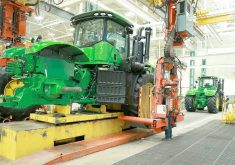During the decade from 1996 to 2006, the world became accustomed to stable crop production. In such a world it was easy to argue that reserves were unnecessary, because there would always be someone with a supply they were willing to export.
This year, hot weather in Eastern Europe and wet weather in the U. S. have resulted in the expectation of tighter crop supplies and higher prices. It was a similar yet different and more extreme scenario three years ago that led to a meteoric increase in crop prices that resulted in embargoes, food riots, and an increase in the number of hungry people in the world.
Read Also

Guarding against misinformation: Do you believe in house hippos?
Misinformation and disinformation run rampant in today’s digital age. Farmers must be wary of the digital dangers and know how to keep themselves safe.
Is the crop production variability we have seen since 2006 the result of the normal forces or climate change? It is probably too soon to attribute these particular events to one cause or the other.
What we do know is that in the past we have seen decades like 1996 to 2006 with few widespread production problems and decades like the 1930s when they seem to happen on a regular basis.
Whatever the cause of erratic production problems, the policy that is needed to protect both producers and consumers is the same – reserves.
Not too long ago, we were one of the very few calling for a discussion of reserves. We were told that we were clinging to the failed policies of the past and that globalization would take care of the problem.
Then came 2007 and 2008 and some at the United Nations Food and Agricultural Organization (FAO) gingerly broached the issue as an element of food security, especially for the poorest of the poor.
Need for publicly held reserves
This year Russia was too hot and dry and we were too wet at the wrong time and prices began to shoot upward. Now we find theEconomistand theFinancial Times(London) calling for reserves on their editorial pages. It is becoming increasingly apparent that commercial traders have no incentive to hold reserves and at times global crop production is not sufficient to meet ever-increasing needs. Thus the need for publicly held reserves.
As agricultural research continues to push yield levels higher, we need to use years of surplus production to create reserves that will be large enough to maintain a comfortable cushion in the face of simultaneous production problems in two or major exporting areas in the same year.
The presence of reserves will stabilize markets in years of adequate, but tight production, while ensuring against the market disruptions that take place in years where production is inadequate.
While it is obvious how reserves can protect consumers – ensuring them of an adequate supply – farmers are worried that reserves will deprive them of the chance to get a fair price for their crop. We have often heard that reserves overhang the market, resulting in prices that are below the cost of production.
With poorly administered reserve policies, that certainly has been the case. It is a matter of keeping the market release rules out of the way of normal price fluctuations.
To be fair to farmers, the floor price level needs to be high enough to ensure that they can earn the bulk of their livelihood from the marketplace.
To be fair to consumers, the reserves have to be large enough to protect them against unacceptably wide swings in prices. The reserve program should be creditable enough so as to minimize disruptions in international trade from the imposition of trading restrictions and hoarding by exporting and importing countries.
DaryllE.RayandHarwoodD. SchafferarewiththeAgricultural PolicyAnalysisCenter(APAC)atthe UniversityofTennessee
———
Whateverthecause oferraticproduction problems,thepolicy thatisneededtoprotect bothproducersand consumersisthesame– reserves.














